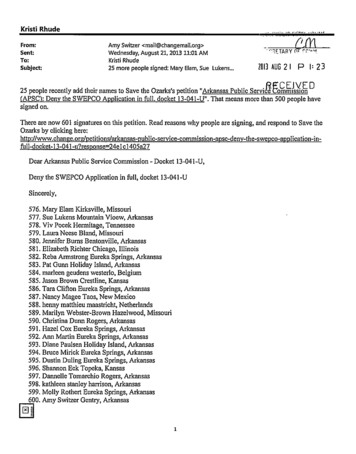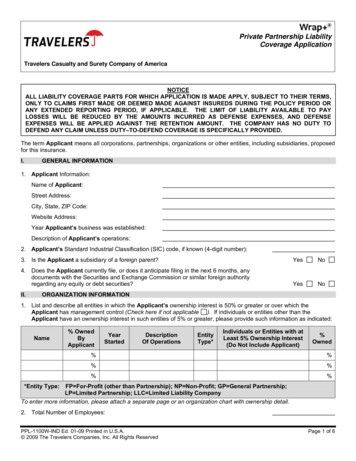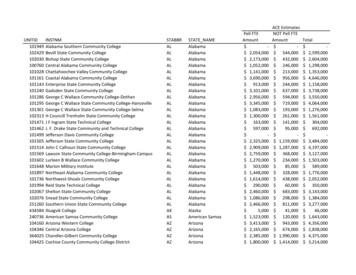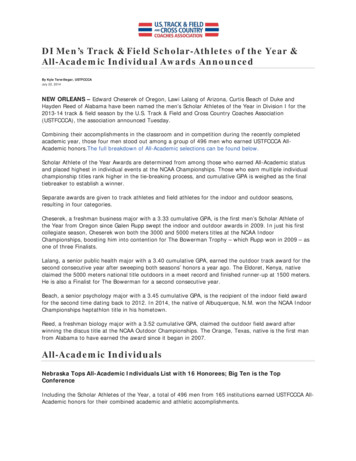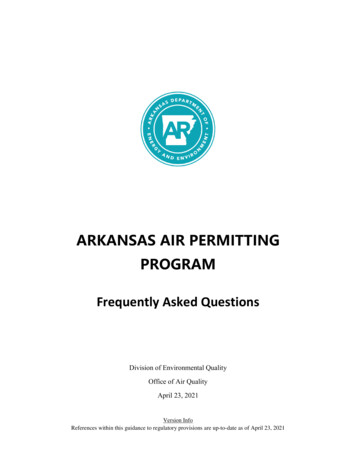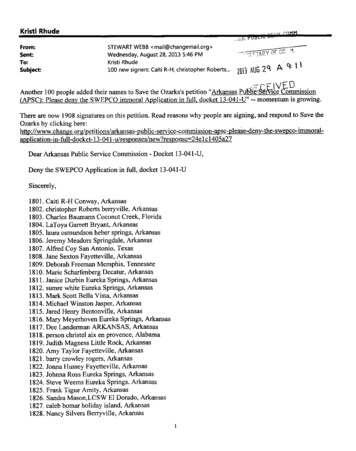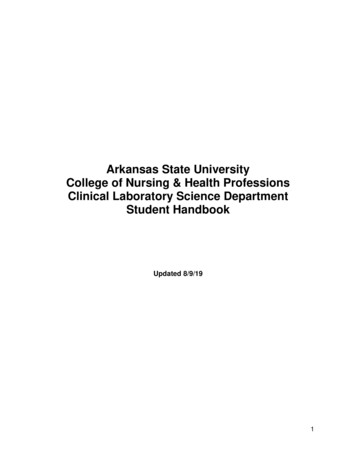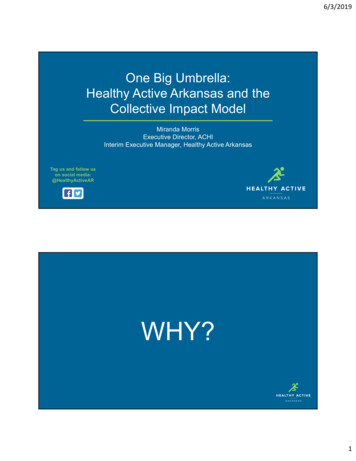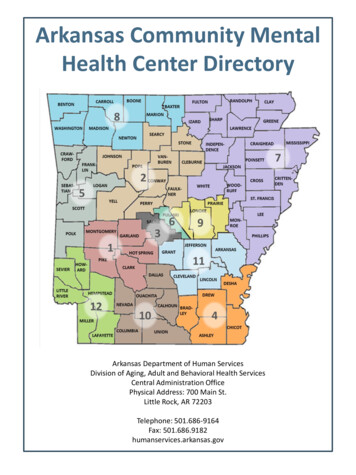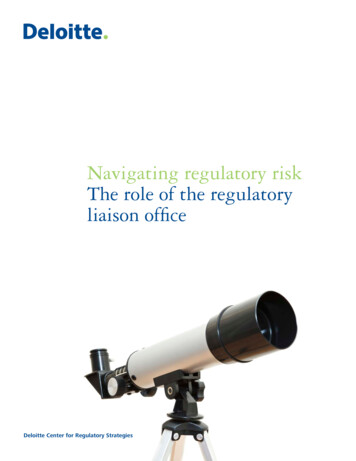
Transcription
ARKANSAS STATEPARTNERSHIPHEALTHINSURANCEMARKETPLACEYEAR ONEEVALUATION
CONTRIBUTORSUNIVERSITY OF ARKANSAS FOR MEDICAL SCIENCESFAY W. BOOZMAN COLLEGE OF PUBLIC HEALTHJ. Mick Tilford, PhDMir Ali, MST. Mac Bird, PhDStephen Bowman, PhD, MHAJake Coffey, MA, MPS, MPHKaren Drummond, PhDHolly Felix, PhD, MPHLiz Gates, JD, MPHM. Kathryn Stewart, MD, MPHARKANSAS FOUNDATION FOR MEDICAL CAREMelanie Boyd, MSKristina Bondurant, PhD, MPHAnita Joshi, BDS, MPHPedro Ramos, PhDNichole Sanders, PhDMayumi Takada
TABLE OF CONTENTSExecutive Summary. 3Introduction . 11I. Evaluate Effectiveness of Governance Process . 17II. Evaluate Effectiveness of Outreach and Education Efforts . 49III. Profile of Qualified Health Plans Enrolled and Seeking to Enroll in the Arkansas StatePartnership Health Insurance Marketplace . 63IV. Evaluate Effectiveness of In‐Person Assister Guide Training . 87V. Evaluate Effectiveness of In‐Person Assisters and Federal Navigators . 111VI. Assess Outcome of Open Enrollment . 127VII. Evaluate Impact on Consumer Health Care. 139VIII. Evaluate Impact on Health Care Providers . 161IX. Develop a Year Two plan for ongoing evaluation . 203
2
EXECUTIVE SUMMARYThe goal of this evaluation of the first year of Arkansas’ State Partnership Health InsuranceMarketplace (SPM) was to examine the effectiveness of processes and procedures used inimplementing the SPM in Arkansas and the outcomes achieved with early implementation ofthe SPM. Arkansas Insurance Commissioner Jay Bradford, with governing authority delegatedby Governor Mike Beebe, was responsible for implementing the SPM in Arkansas under astate/federal partnership. The Arkansas Health Connector Division (AHCD) within the ArkansasInsurance Department (AID) led the implementation of the SPM under the guidance of DeputyCommissioner Cindy Crone, APN, MNSc. The AHCD responsibilities included: 1) developingpolicies and procedures to support Qualified Health Plan (QHP) certification, re‐certification,and plan monitoring; 2) advancing quality and payment transformation initiatives through theMarketplace; 3) supporting education and re‐licensure of Marketplace assisters includinglicensed producers; 4) implementing Marketplace outreach and education activities; and 5)ensuring adequate staffing of the Arkansas Health Connector Resource Center(AHCRC) toprovide timely response to consumer inquiries or complaints.The evaluation plan for this report was developed in collaboration with the AID. Thefederally funded evaluation was supported through a contract between the Arkansas InsuranceDepartment and the University of Arkansas for Medical Sciences Fay W. Boozman College ofPublic Health (COPH) under the direction of J. Mick Tilford, PhD. The COPH subcontracted withthe Arkansas Foundation for Medical Care (AFMC) to assist with the evaluation.OBJECTIVES AND DATA SOURCESThe evaluation plan focused on nine objectives that were to be completed in the first yearfollowing implementation of the SPM. The evaluation objectives included: evaluating theeffectiveness of the governance process, evaluating the effectiveness of outreach andeducation efforts, developing a profile of qualified health plans enrolled and seeking to enroll inthe SPM, evaluating the effectiveness of in‐person assister (IPA) guide training, evaluating theeffectiveness of IPAs and federal navigators, assessing the outcomes of open enrollment,evaluating consumer perceptions of health plans and services, evaluating provider perceptionsof the implementation of the SPM and its impact on their operations, and finally, developing aplan for continued evaluation of the SPM based on lessons learned.Data for the evaluation came from a number of sources including both qualitative andquantitative survey methods. Qualitative data were obtained from semi‐structured interviewswith key informants. These data were recorded and transcribed for analysis with allrespondents remaining anonymous. A consumer survey was fielded that obtained responsesfrom over 1,000 Arkansans participating in the SPM with approximately half of the respondents3
having obtained insurance through Arkansas’s expanded Medicaid program and the other halfthrough direct purchase in the SPM. A provider survey was fielded with three groups ofproviders: hospitals, physician practices, and behavioral health providers. Finally, the evaluationrelied on various data sources within the AID and other public sources to accomplish some ofthe objectives. The evaluation team thanks the consumers, providers, stakeholders, andcarriers that gave their time and resources to help us accomplish our objectives.KEY OUTCOMESIn 2014, Arkansas had three state insurers and one multi‐state carrier participating in theSPM. Plans were offered in all seven regions of the state with the southeast and southwesthaving only two participating insurers. A total of 13,341 QHP items were reviewed by AID withall 71 plans (23 Gold, 16 Silver, 24 Bronze, and 8 Catastrophic) that were submitted by the fourparticipating carriers certified for plan year 2014.As of April 19, 2014, 43,446 (19.1%) of the 227,000 Arkansans who were eligible forMarketplace insurance enrolled through the SPM. Program enrollment grew to 68,131Arkansans as of April 1, 2015. An analysis of active QHP status revealed that 82% of SPMenrollees were either current on payment, had first payment pending, or were still within thegrace period.In addition to subsidized purchases of health insurance through the SPM, the ArkansasMedicaid program also purchased high‐level silver QHPs for approximately 213,000 enrollees.The Medicaid beneficiaries in the SPM (Health Care Independence Program (HCIP) enrollees)are thought to have improved the SPM by increasing the pool with low risk, healthy people,thus lowering the cost of subsidized insurance for all enrollees.Through the combined enrollment of the Marketplace and the HCIP enrollees, thepercentage of adults in Arkansas without health insurance fell from 22.5% in 2013 to 11.4% in2014. The reduction in the percentage of uninsured was the largest decrease in the country andcelebrated by many of the stakeholders who were involved in the implementation of the SPM.The survey results from 1,212 consumers in the SPM provided important information aboutthe characteristics of enrollees, including those enrolled through HCIP. A larger percentage ofenrollees were female (approximately 60%), with an average age of 41 years. Approximately19% of enrollees reported as being African American or black and approximately 4% listedthemselves as Hispanic. Most of these characteristics were significantly different than nationalsurveys of enrollees in state Medicaid programs.The consumer survey included both Marketplace and HCIP enrollees, and as a result wewere able to identify key findings with respect to prior insurance coverage for both groups. For4
enrollees in the Marketplace, approximately 53% had insurance in the six months prior toobtaining health insurance coverage in the SPM compared to 27% in the HCIP. Enrollees in theHCIP were much less likely to have had any health insurance coverage since becoming an adultwith 45.1% reporting receiving health insurance coverage for the first time since turning 18years of age. In contrast, 20.1% of enrollees in the Marketplace reported receiving insurance forthe first time as an adult.The characteristics of enrollees receiving health insurance for the first time as an adultdiffered considerably between HCIP enrollees and Marketplace enrollees. The average age ofrespondents in the HCIP who reported having insurance for the first time as an adult was 36years while Marketplace enrollees averaged 42 years. There also were large differences inhealth status between enrollees in the Marketplace and HCIP. Of enrollees who were gettinginsurance for the first time, 34.6% of enrollees reported excellent health status – a rate threetimes the sample average. However, only 7% of HCIP enrollees reported being in excellenthealth, a rate that is close to, but below the sample average. The large percentage of newlyinsured enrollees in the Marketplace who reported excellent health status points to thepotential for cost advantages from including HCIP enrollees in the Marketplace to lower costssufficiently to attract healthy enrollees.Enrollees were compared on their ability to access health services using data from theNational CAHPS Benchmarking Database (NCBD). Overall, findings within the state of Arkansaswere mostly consistent with national data with some exceptions. Approximately 82% ofenrollees in the SPM reported getting needed care compared to 81% in the NCBD. Enrolleeratings associated with getting care quickly were lower in the SPM compared to the NCBD whileratings of customer service were higher in the SPM. Enrollees in Arkansas were less satisfiedoverall with their health plan compared to respondents in the NCBD with 62% of SPM enrolleesrating their health plan favorably compared to 75% nationally. This difference may be due tothe cost sharing features of plans purchased through the SPM that were not required ofrespondents in the NCBD.The consumer survey provided data on health services utilization by enrollees. There wasconsiderable variation in doctor visits across the seven regions. Enrollees in the southeast andsouth central regions had lower doctor utilization (54‐60%) compared to the state average of73.3% having at least one visit in the last six months. Enrollees were asked whether they had anurgent medical care condition that required care, and if so, whether they visited an emergencydepartment. Overall, 18% of SPM enrollees indicated having at least one emergencydepartment visit. Enrollees in southeast Arkansas had the highest emergency departmentutilization rate at 27.5%, which is consistent with the historically low access to health careservices in that region. In contrast, enrollees in the northeast region had higher than average5
rates of doctor utilization and lower than average rates of emergency department utilization.There was some concern raised over the high rate of utilization of doctors by SPM enrollees.Over 40% of respondents reported having three or more visits to the doctor in the past sixmonths. Comparative data from alternative sources and longitudinal studies are needed toassess whether a pent‐up demand for care exists among a large percentage of enrollees andhow utilization patterns will change over time.IMPACT ON HEALTH CARE PROVIDERSSurveys were conducted with hospitals, clinics, and behavioral health providers to identifychanges in patient volume, uncompensated care costs, and patient mix resulting fromimplementation of the SPM. Findings from the surveys suggested hospitals benefited the mostfrom decreased uncompensated care costs with 77.8% of responding hospitals reporting adecrease following implementation. In contrast, approximately 22‐27% of clinics and behavioralhealth providers reported a decrease in uncompensated care costs. Most hospitals reported nochange in patient volume following implementation of the SPM and more hospitals reported adecrease in volume compared to an increase in volume. Twenty‐five percent of clinics reportedincreases in patient volume, while 11% of behavioral providers reported an increase comparedto 6% that reported a decrease in volume. All types of providers reported changes in patientmix following implementation of the SPM with increased volume in Medicaid and privatelyinsured patients and decreased volume in uninsured patients.The survey also included questions about education of patients and a large percentage ofproviders noted that education of patients was insufficient and that more work was warranted.In addition, providers reported difficulty in identifying patients by insurance type in the SPM.The inability to identify a patient’s insurance status (Marketplace or HCIP) creates billingproblems as some patients have cost sharing provisions while others do not.EVALUATION OF IMPLEMENTATION ACTIVITIESThe AHCD within AID faced many challenges in implementing the SPM that led to the keyoutcomes described above. A major focus of the implementation plan was the use of IPAs andnavigators as well as community events and paid media advertising to provide consumers withthe necessary information to enroll. The AHCD conducted a needs assessment to determine thenumber of IPAs to employ using federal grant funding. The AHCD eventually contracted for theemployment, training, and management of over 500 IPAs to assist consumers to enroll in theSPM. The organizations with whom AHCD contracted invested substantially in communityevents by providing over 43,000 outreach and education events across the entire state.Successful implementation of this approach required the development and delivery of atraining curriculum, execution of contracts with agencies to hire and provide services, and the6
development of a system to monitor the process. All of the IPA and navigator activities, inaddition to other activities associated with the development of the SPM, occurred in anuncertain environment with difficult state political issues and federal coordination problems,many of which are described in the evaluation report.As a result of the emphasis on the use of IPAs and navigators to provide consumerassistance with the SPM, this evaluation assessed several key questions including theeffectiveness of IPA training, the effectiveness of outreach and education activities, and theeffectiveness of using IPAs and navigators as a system to provide information to consumers forenrollment into the SPM.GOVERNANCEThe evaluation team used qualitative assessments to evaluate the governance structure andstakeholder engagement process that was established up by the AHCD under the direction ofAID Deputy Commissioner Cynthia Crone, to implement the SPM. The governance structure forthe AHCD included a steering committee, a plan management advisory committee, and aconsumer assistance advisory committee. The AHCD also included a vendor for projectmanagement and planning in addition to staff and vendors for in‐house operations, technology,legal, plan management, and consumer support. The qualitative interviews covered all aspectsof the AHCD governance structure and were completed using semi‐structured interviews.In general, the results point to the successful implementation of all key activities despitetime pressures and other political issues. The primary challenges in implementing the SPMidentified by the evaluation team were: 1) delays and constant changes that came down fromthe federal and state levels, and 2) the state legislature’s decision to shut down all consumeroutreach and education efforts. Given the decision to shut down outreach and educationefforts, there is considerable room for debate over whether the findings on the effectiveness ofthis approach to enroll and educate consumers would have been different without midcoursechanges in policy. However, the evaluation team identified several issues that warrant furtherconsideration.IN‐PERSON ASSISTER GUIDE EDUCATION AND EFFECTIVENESSThe process of training and licensing in‐person assister guides (IPA) was complicated by theneed to develop a suitable curriculum, to identify methods for delivering the curriculum (onlineor in‐person), and the lack of tools for actually navigating the Marketplace given that ademonstration website from the federal government was not available. Despite thecomplicated issues surrounding education and licensure, the evaluation findings suggest thatthe curriculum and educational activities were successful.7
The evaluation team found support for the premise that IPAs and navigators can facilitateconsumer education and increase the ease of enrolling in the Marketplace. The findingsindicate a positive relationship between IPA activities and enrollment based on data from theGuide Management System that was used to track and manage processes related to the IPAs.The evaluation did not address the cost‐effectiveness of using IPAs or whether otherapproaches such as targeting low literacy areas would be a better option compared to theapproach taken. The consumer survey found that only 28% of enrollees used a person to assistwith enrollment into the SPM. Of the consumers who used assistance, approximately 40% usedan insurance agent. The findings also indicated that enrollees who used in‐person assistance toenroll were approximately 10 percentage points more likely to say that the enrollment processwas definitely easy.It is unknown to what extent the enrollment numbers and other outcomes of enrollmentwould have changed had outreach and education activities not been terminated. It is worthnoting that enrollment in the Marketplace grew from approximately 43,000 enrollees in thefirst year to approximately 68,000 enrollees in the following year in the absence of any mediaor outreach and education activities. Still, a large number of Arkansans remain eligible forfederally subsidized health insurance and face penalties for not obtaining insurance. Enrollingmore Arkansans in the SPM is likely to further increase the volume of visits to primary careclinics and continue the decline in uncompensated care costs to the state that began withimplementation of the SPM.FUTURE EVALUATION ACTIVITIESThe evaluation team considered future evaluation activities based on lessons learned fromthe first year evaluation that could be useful as the SPM transitions from a federal/statepartnership model to a state‐based insurance marketplace. Several themes were identified thatshould be considered in this context. As a state‐based health insurance marketplace, it is criticalto consider the cost‐effectiveness of different activities and to focus survey and data collectionefforts toward this criteria. For example, the consumer survey fielded as part of this evaluation,contained numerous questions on the use of in‐person assistance given the focus of theimplementation approach. These types of questions are of much less importance and should bereplaced by other domains not covered in the prior evaluation. In particular, it is important tostudy the effectiveness of branding. New questions could be added about why consumersobtain health insurance, whether consumers are aware of SPM branding and other messages,and whether consumers need other services currently not provided through the SPM.While the consumer survey asked questions about general physical and mental health,more specific instrument for measuring health and productivity are available and should beconsidered. The historic decrease in the uninsured and the consequent increase in access to8
health services by low income populations in Arkansas should have important health effects forSPM enrollees. Sensitive continued measures to understand the extent of this improvement iswarranted.The recent passage of Arkansas Act 1233 to create the Arkansas Healthcare TransparencyInitiative of 2015 could lead to establishing significant data infrastructure for SPM evaluationaimed at cost‐effectiveness. In particular, the creation of an all payer claims database could beused to construct a number of metrics including: Trends in per capita emergency department useTrends in per capita hospitalization useOverall expenditures by public and private payersPrices for bundles of services provided by public and private payersRisk adjusted per member per month expenditures by public and private payersRelationships between geographic access to health services and utilization of emergencydepartmentsWith simple identifiers included in the database, it would be possible to assess whetherconsumers are making rational decisions with respect to insurance purchases leading to neweducational efforts to improve choices.SUMMARYDespite difficult timelines and other political and logistical challenges, the AHCDimplemented the SPM and facilitated health insurance enrollment for a large percentage ofpeople who otherwise would have remained uninsured. This historic achievement appears tohave increased the use of primary care services and decreased uncompensated care costs inthe state. A large number of Arkansans remain eligible for federally subsidized health insuranceand efforts to increase their enrollment in the SPM should be a priority going forward. Futureevaluations will be needed to establish whether the health and productivity of Arkansans whoenrolled under the SPM improved and whether this grand experiment provided benefits inexcess of costs.9
10
INTRODUCTIONThe development of the evaluation plan for the Arkansas State Partnership HealthInsurance Marketplace (SPM) was based on a prior report to the Arkansas InsuranceDepartment (AID) titled Arkansas Health Benefits Exchange planning project: Evaluation Plan.That evaluation plan was developed under contract by First Data and dated August 19, 2011(Version 2.0). The prior evaluation plan provided guidance for four years beginning withimplementation of the insurance exchange in Arkansas by the Arkansas Health ConnectorDivision within AID. This report describes the first year evaluation based on the proposedmethods and measures contained in that report.The initial evaluation plan described the Arkansas Exchange as the Health Benefits Exchangeconsistent with naming the original division within AID the Health Benefits ExchangePartnership Division. The division subsequently changed to the Arkansas Health ConnectorDivision (AHCD) following a market study and branding of the Arkansas Health Connector as thestate's "Guide to Health Insurance." With this change, the Arkansas Exchange became formallyknown as the Arkansas State Partnership Health Insurance Marketplace.The focus of the initial evaluation plan was on implementation of the SPM in Arkansas, theoutcomes associated with implementation of the SPM, and whether the process was cost‐effective. Implementation activities under the guidance of the AHCD included 1) developingpolicies and procedures to support Qualified Health Plan (QHP) certification, re‐certification,and plan monitoring; 2) advancing quality and payment transformation initiatives through theMarketplace; 3) supporting continuing education and re‐licensure of Marketplace assistersincluding licensed producers; 4) implementing Marketplace outreach and education activities,and 5) ensuring adequate staffing of the Arkansas Health Connector Resource Center to providetimely response to consumer inquiries or complaints. The successful completion of theimplementation plans were expected to lead to increased enrollment in the SPM and decreasedrates of uninsured individuals in Arkansas as well as improved quality of healthcare delivery andimproved health outcomes for the population.Results of the evaluation indicate that by April 19, 2014, 43,446 (19.1%) of the 227,000Arkansans eligible for Marketplace insurance enrolled through the SPM. Program enrollmentgrew to 68,131 Arkansans as of April 1, 2015. An analysis of active status revealed that 82% ofSPM enrollees were either current on payment, first payment was pending, or the enrolleeremained within the grace period.A full evaluation of the implementation, outcomes, and cost‐effectiveness of the SPM asdescribed in the initial planning proposal could not be accomplished in a first‐year evaluation.For example, the original evaluation plan proposed getting information on use of the11
emergency department to assess whether there was inappropriate utilization. Similarly, theoriginal plans sought information on clinical outcomes related to cardiovascular and diabetescare, as well as Health Effectiveness Data Information Set (HEDIS) indicators. To calculate thesemeasures would require electronic claims or medical record data as specified in the planningdocument. It was not possible to obtain claims data (and other proposed data sets) to calculatethese measures for the first‐year evaluation. Thus, the evaluation is limited in scope to activitiesthat could be accomplished within the first year focusing on implementation and outcomes ofopen enrollment. We did not assess the cost‐effectiveness of specific implementation activities,as evidence of effectiveness would be needed before assessing outcomes in relation to cost.The evaluation was completed through a cooperative agreement between the University ofArkansas for Medical Sciences Fay W. Boozman College of Public Health (COPH) and theArkansas Foundation for Medical Care (AFMC). We gratefully acknowledge the cooperation ofthe carriers, consumers, and other stakeholders in securing the necessary data for this report.EVALUATION DATA AND ACTIVITIESThe initial evaluation plan called for several sources of data that could be used to evaluatehow well the AHCD implemented the SPM and the outcomes of open enrollment. The majordata source called for within the initial evaluation plan was a population‐based consumersurvey of enrollees. The evaluation team for this report responded to this call by developing a102 question survey that asked consumers for information related to their health and recentuse of health care services, their health care provider(s), how they enrolled and any assistancethey received doing so, how satisfied they were with the assistance they received, how theychose a health plan and their experience using the health plan, and how satisfied they werewith their experience with the enrollment process and health plan. The survey was mailed toenrollees in the state using addresses provided to AID by the carriers. Details of the methodsand sampling procedures are described in the body of the report and summarized below.The Arkansas Foundation for Medical Care (AFMC), a National Committee for QualityAssurance (NCQA) Certified Health Plan Employer Data and Information Set (HEDIS ) SurveyVendor and, as part of the evaluation, conducted the 2014 Consumer Health Care Survey withenrollees in the SPM health insurance plans. The survey instrument included questions fromthe Consumer Assessment of Healthcare Providers and Systems (CAHPS ) 5.0H AdultCommercial Survey, Centers for Medicare and Medicaid Services (CMS) Health InsuranceMarketplace Survey and CMS Adult Qualified Health Plan Enrollee Experience Survey andadditional questions designed to address specific evaluation needs. The survey wasadministered by mail and through SurveyMonkey from November 2014 through February2014 with a 27.6% response rate. The survey data was used to assess enrollee satisfaction inboth the SPM and HCIP groups.12
The initial evaluation plan also called for a number of data sources to evaluate the use of in‐person assister guides (IPA) and navigators given the central role they would play inimplementation of the SPM. We used qualitative techniques to gather data on the effectivenessof the IPAs and navigators as well as to study the governance process, outreach and educationefforts, and other objectives. The qualitative data was obtained using semi‐structuredinterviews as it was believed this method would produce better information on sensitive issuescompared to focus groups. All of the qualitative information was collected in a manner toensure anonymity. We also relied on existing data sources from AID and other organizations tocharacterize the outcomes of open enrollment and issues related to the training andeffectiveness of IPAs and navigators. Greater description on the data sources as well as detailson the qualitative methods can be found in the body of the report.Finally, team members from AFMC developed and fielded a survey of providers to gaugetheir experience with the SPM. This survey was conducted with hospitals, physicians, andbehavioral health care providers. The survey focused on the impact of the SPM on key metricssuch as impact on uncompensated care costs, patient access, and reimbursement. The surveywas fielded early in the implementation of the SPM and may not capture the full effects of theSPM as it grew substantially over time. An important recommendation for further evaluation iscontinued monitoring of providers with respect to these key metrics.EVALUATION GOALS AND OBJECTIVESBased on the prior evaluation plan and the feasibility of accomplishing goals within the firstyear, nine goals and an accompanying set of objectives were planned. The goals weredeveloped in collaboration with the AHCD and formalized through a contract with the COPH.The COPH subcontracted with AFMC to complete four of the nine project goals (ProfileQualified Health Plans Enrolled and Seeking to Enroll in the SPM, Assess Outcome of OpenEnrollment, Evaluate Impact on Consumer Health Care, and Evaluate Impact on Health CareProviders). This section summarizes each of the nine evaluation goals.EVALUATE EFFECTIVENESS OF GOVERNANCE PROCESSThe effectiveness of the governance process was assessed through key informant interviewswith members of the Steering Committee, Plan Management Committee, Consumer AssistanceAdvisory Committee, AID staff, and contractors working directly with the AHCD. The interviewsfocused on the individual’s perceptions of the stakeholder engagement process, remainingchal
In addition to subsidized purchases of health insurance through the SPM, the Arkansas Medicaid program also purchased high‐level silver QHPs for approximately 213,000 enrollees. The Medicaid beneficiaries in the SPM (Health Care Independence Program (HCIP) enrollees)

